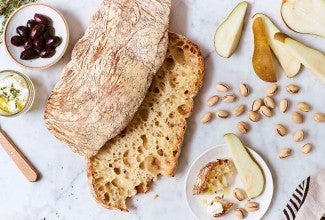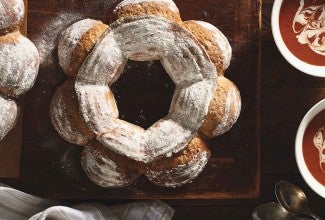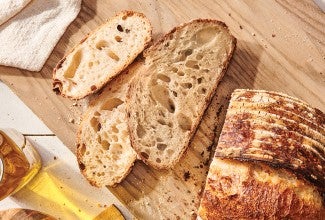-
To make the biga: Weigh your flour; or measure it by gently spooning it into a cup, then sweeping off any excess. In a medium-sized mixing bowl, combine all of the biga ingredients, cover, and set aside for 12 to 24 hours. This pre-ferment is ready to use when it's developed large holes, looks very puffy, and is domed in the center. If the center has fallen, the pre-ferment is overripe but can still be used. Your bread will have slightly more of a tang to it.
-
To make the dough: Combine the biga, flour, water, salt and yeast — by hand, mixer, or bread machine — kneading to form a smooth and supple dough.
-
Knead in the apricots, raisins and pecans. (If you're using a bread machine, add them about 5 minutes before the end of the final kneading cycle. After the dough is kneaded, remove the bread from the basket and place it in a lightly greased bowl to rise.)
-
Transfer the dough to a lightly greased bowl or dough-rising bucket, cover the bowl or bucket, and allow the dough to rise for 45 minutes.
-
After 45 minutes uncover the bowl and, using a bowl scraper or spatula, run the scraper or spatula down the inside far wall of the bowl. Bring the dough up from the bottom of the bowl, and fold it over on top of itself. Turn the bowl 90° and repeat; repeat twice more (for a total of four times), turning the bowl 90° each time. This process, which helps develop the dough, is called a fold. Re-cover the bowl, and let the dough rise for another 45 minutes before adding another fold.
-
Re-cover the bowl and let the dough rise for an additional 30 to 60 minutes, until the dough is billowy (but not necessarily doubled in bulk). Divide the dough into three pieces, each weighing approximately 1 pound (454g).
-
Pre-shape the pieces into loose rounds, let the rounds rest for 15 minutes, covered, then form them into oval loaves (bâtards).
-
Cover the loaves with greased plastic wrap or a dough cover, and let them rise for 1 hour, or until they're puffy.
-
The loaves may be baked at this point, but will have better flavor if they're refrigerated, covered, for 4 hours, or up to about 16 hours. Remove the loaves from the refrigerator, and let them rest at room temperature, covered, for 25 to 30 minutes while you're preheating the oven.
-
If you're using a baking stone, preheat the oven to 475°F for at least 30 minutes. If you're going to bake the loaves on sheet pans, preheat the oven to 450°F.
-
Just before putting the loaves into the oven, spritz them with water or brush them with an egg white thinned with 2 tablespoons water. Use a lame or a very sharp knife to score the loaves several times across the top.
-
Place the loaves in the oven. If you're using a stone, immediately reduce the oven heat to 375°F. If you're baking on sheet pans, wait 10 minutes, then reduce the heat to 375°F.
-
Bake the bread for 25 to 30 minutes, until it's dark brown. Remove the bread from the oven, and cool it on a wire rack.
-
Store well-wrapped at room temperature for up to 5 days, or frozen for up to 3 months.


















